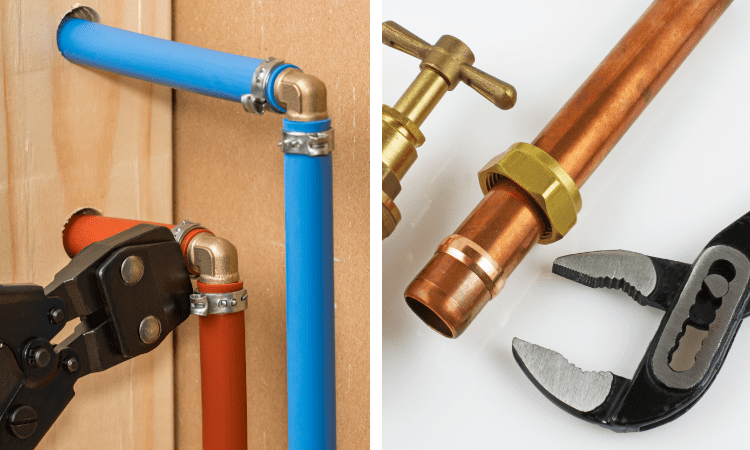One common concern for many homeowners is how to prevent pipes from freezing, especially in areas that experience freezing temperatures. Copper pipes have been the traditional choice for plumbing systems, but PEX pipes have gained popularity in recent years.
So, is PEX better than copper for freezing? Yes, PEX pipes are an excellent choice for freezing conditions due to their flexibility. This enables them to withstand extremely cold temperatures without cracking or breaking. However, copper pipes are susceptible to cracking in freezing temperatures due to their rigidity.
In this article, we will compare PEX and copper pipes and determine which one is better suited for areas prone to freezing temperatures.
Is Pex Better than Copper for Freezing?
Let’s find out by going through a comparison table.
| PEX Pipes | Copper Pipes | |
| Material | Cross-linked polyethylene plastic | Copper metal |
| Flexibility | Highly flexible, able to expand and contract without cracking | Less flexible, can be prone to cracking and bursting in freezing temperatures |
| Durability | Generally less durable than copper pipes, but can last up to 50 years | Highly durable, can last up to 70 years or more |
| Cost | Generally less expensive than copper pipes | Generally more expensive than PEX pipes |
| Installation | Relatively easy to install and requires fewer fittings than copper pipes | More difficult to install and requires more fittings than PEX pipes |
| Water Quality | May leach trace amounts of chemicals under certain conditions | May leach lead into the water supply if joined with lead-based solder |
Also, look into this video to get a better understanding of whether to choose PEX or copper through freeze testing:
Copper and PEX Pipe Comparison
Copper and PEX pipes are two popular plumbing system components. Both have benefits and drawbacks and selecting the best material is influenced by a number of variables. That includes regional climate, financial constraints, and personal preferences.
Flexibility
Due to their extreme flexibility, PEX pipes are better suited for freezing temperatures. Even in very frigid conditions, they are capable of expanding and contracting without breaking or splitting. When subjected to cold conditions, copper pipes, which are stiff, might split or rupture.
Adaptability to Freezing
Compared to copper pipes, PEX pipes are more resistant to freezing. Due to their flexibility, they can absorb the pipe’s ice pressure without exploding or shattering. Contrarily, copper pipes are more likely to explode under the same conditions.
Ease of Installation
PEX pipes are more often used for DIY plumbing projects than copper pipes because they are simpler to install. Copper pipes need more sophisticated equipment and soldering, but PEX pipes just need basic gear.
Corrosion Protection
While PEX pipes are more vulnerable to damage from UV light and some chemicals than copper pipes, copper pipes are known for their excellent corrosion resistance. Although scaling and mineral buildup can reduce water flow and increase maintenance needs, PEX pipes are more resistant to these issues.
Cost
Although PEX pipes are typically less expensive than copper pipes, the final cost will depend on a number of variables. This includes the project’s size, labor costs, and the cost of materials in the region.
Copper pipes have benefits in terms of durability and resistance to corrosion. It’s crucial to take into account all the variables and choose the material that best suits your requirements and price range.
PEX Pipes’ Benefits and Drawbacks for Freezing
The major advantages you should consider while choosing PEX over copper are:
● Flexibility
As was already noted, PEX pipes are quite flexible, which makes them a great choice for locations with cold conditions. Because they are resistant to expansion and contraction, pipes are less likely to burst.
● Easy installation
PEX pipes are a great choice for do-it-yourself plumbing projects since they are simple to install and only need a few pieces of basic equipment.
● Corrosion resistance
While PEX pipes are susceptible to UV light and some chemicals, they are more resistant to scaling and mineral buildup than copper pipes. This lessens the likelihood of decreased water flow and raises maintenance needs.
There are disadvantages of PEX pipes as well. Let us explore them as well:
Longevity
PEX pipes last for 30 to 50 years. The lifespan of PEX can be reduced due to exposure to excessively hot water (at or above 180 degrees Fahrenheit) or if the household water has elevated levels of chlorine.
Chemical leaching
BPA and phthalates have been documented to seep into the water supply using PEX pipes. Although the levels are typically within safe limits, those who are sensitive to these chemicals may find this to be a problem.
Fittings
PEX pipes need specialized equipment and fittings, which might raise the entire cost of installation.
UV sensitivity
Over time, PEX pipes may deteriorate and become brittle due to their sensitivity to UV radiation. In places where there is a lot of sunshine exposure, this can be a problem.
Because of its flexibility and resistance to bursting, PEX pipes are a great choice for freezing situations. But for some people, worries about their long-term robustness and chemical leaching might be a factor.
The Benefits And Drawbacks Of Using Copper Pipes For Freezing
Let us first discuss the advantages of Copper pipes:
● Durability
Copper pipes are renowned for their longevity and durability. They are a fantastic alternative for places with cold climates since they can resist harsh temperatures.
● Resistance to rust
Copper lines are very immune to corrosion, which makes them a great choice for places with hard water. They are resistant to corrosion and deterioration and can survive mineral accumulation.
● Accessibility
Finding and installing copper pipes is simple since they are widely distributed.
And the disadvantages are:
Rigid
Due to its rigidity and lack of flexibility, copper pipes are more prone to breaking and bursting at subfreezing conditions.
Cost
Copper pipes may be expensive, particularly if installation work is included.
Installation takes time
Copper pipes need special tools and fittings, and installing them is time-consuming.
Risk of theft
Due to their high resale value, copper pipes are a common target for theft.
Although copper pipes are generally more rigid and expensive than PEX pipes, they are still a reliable and long-lasting option for freezing conditions. Before selecting the type of plumbing material to use, it is crucial to consider all the relevant factors.
Which Is Safer? Copper Or Pex Pipe
Using PEX and copper pipes in plumbing systems is usually considered safe. However, there are several things to bear in mind. Let us look into the points to consider the safer one.
Copper Pipes:
- Choose this plumbing system for its exceptional durability and corrosion resistance, ensuring long-lasting and reliable performance
- Plumbing professionals have relied on these tried-and-true fixtures for decades due to their unparalleled reliability
- Fire resistance is a crucial safety aspect for both residential and commercial structures
PEX pipes:
- Flexible plastic pipes are a cost-effective and convenient alternative to copper pipes, offering easy installation and durability
- Stay safe in colder regions with our freeze-resistant products that are designed to withstand low temperatures and reduce the risk of bursting
- Potential Chemical Leaching into Water Supply
- Selecting certified PEX pipes for potable water systems is important
- Also, adhering to manufacturer guidelines for installation and upkeep is crucial for ensuring top-notch quality
As long as they are installed properly and adhere to safety standards, PEX, and copper pipes can both be used in plumbing systems without any risks.
In order to make sure that the components and installation adhere to safety regulations, it’s essential to choose a trustworthy plumbing supplier and installer.
Conclusion
In conclusion, when it comes to freezing conditions, copper and PEX pipes both have benefits and downsides. PEX pipes are more flexible and can endure cold temperatures without splitting or bursting better than copper pipes. It is typically more resilient and lasts longer.
However, there are other factors to take into account as well when deciding between PEX and copper pipes for your plumbing system. It includes cost, ease of installation, and water quality. Ultimately, the decision between PEX and copper for freezing should be based on the specific needs and circumstances of the user.

